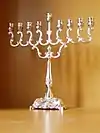Second Temple
The Second Temple (Hebrew: בֵּית־הַמִּקְדָּשׁ הַשֵּׁנִי, romanized: Bēṯ hamMīqdāš hašŠēnī, transl. 'Second House of the Sanctum'), also known in its later years as Herod's Temple, was the reconstructed Jewish holy temple that stood on the Temple Mount in the city of Jerusalem between c. 516 BCE and 70 CE. It replaced the First Temple (built at the same location during Solomon's reign over the United Kingdom of Israel) that had been destroyed in 587 BCE by the Neo-Babylonian Empire during its conquest of the Kingdom of Judah; the fallen Jewish kingdom was subsequently annexed as a Babylonian province and part of its populace was held captive in Babylon.[1] Construction on the Second Temple began some time after the conquest of Babylon by the Achaemenid Persian Empire, following a proclamation by the Persian king Cyrus the Great that enabled the Jewish return to Zion. The completion of the Second Temple in the new Achaemenid province of Yehud marked the beginning of the Second Temple period in Jewish history.
| Second Temple Herod's Temple | |
|---|---|
בֵּית־הַמִּקְדָּשׁ הַשֵּׁנִי | |
 Model of Herod's Temple (the Second Temple after being rebuilt by Herod) currently at the Israel Museum in Jerusalem, created in 1966 as part of the Holyland Model of Jerusalem; the model was inspired by the writings of Josephus. | |
| Religion | |
| Affiliation | Second Temple Judaism |
| Region | Persian Judah |
| Deity | Yahweh |
| Location | |
| Location | Temple Mount, Jerusalem |
| Country | Achaemenid Empire (at time of construction) |
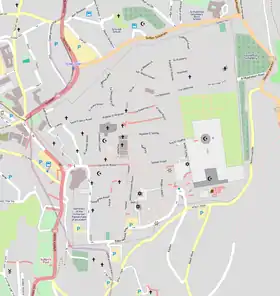 Location within Jerusalem's Old City 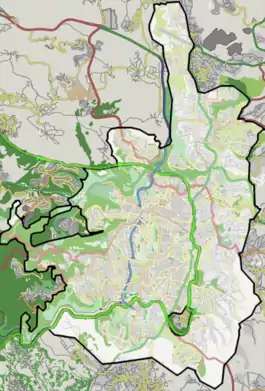 Location within Jerusalem (modern city borders)  Location within the Levant | |
| Geographic coordinates | 31.778013°N 35.235367°E |
| Architecture | |
| Creator | Zerubbabel; expanded by Herod the Great |
| Completed | c. 516 BCE |
| Destroyed | 70 CE |
| Specifications | |
| Height (max) | 45.72 metres (150.0 ft) |
| Materials | Jerusalem limestone |
| Criteria | Second Jewish Temple |
 | |
| History | |
| Founded |
|
| Site notes | |
| Excavation dates | 1930, 1967, 1968, 1970–1978, 1996–1999, 2007 |
| Archaeologists | Charles Warren, Benjamin Mazar, Ronny Reich, Eli Shukron, Yaakov Billig |
| Condition | Destroyed; built over by the Dome of the Rock during Muslim rule in the 7th century CE |
| Ownership | Jerusalem Islamic Waqf |
| Public access | See Temple Mount entry restrictions |
According to the Bible, the Second Temple was originally a rather modest structure constructed by a number of Jewish returnees to the Levant from Babylon under the Achaemenid-appointed governor Zerubbabel. However, during the reign of Herod the Great over the Herodian Kingdom of Judea, it was completely refurbished and the original structure was totally overhauled into the large edifices and façades that are more recognized in modern recreated models.
The Second Temple stood for approximately 585 years before its destruction in 70 CE by the Roman Empire as retaliation for an ongoing Jewish revolt.[2][lower-alpha 1]
Biblical narrative
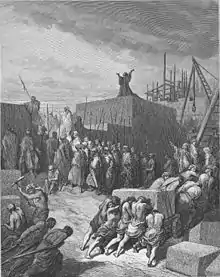
The accession of Cyrus the Great of the Achaemenid Empire in 559 BCE made the re-establishment of the city of Jerusalem and the rebuilding of the Temple possible.[3][4] Some rudimentary ritual sacrifice had continued at the site of the first temple following its destruction.[5] According to the closing verses of the second book of Chronicles and the books of Ezra and Nehemiah, when the Jewish exiles returned to Jerusalem following a decree from Cyrus the Great (Ezra 1:1–4, 2 Chronicles 36:22-23), construction started at the original site of the altar of Solomon's Temple.[1] These events represent the final section in the historical narrative of the Hebrew Bible.[3]

The original core of the book of Nehemiah, the first-person memoir, may have been combined with the core of the Book of Ezra around 400 BCE. Further editing probably continued into the Hellenistic era.[6]
Based on the biblical account, after the return from Babylonian captivity, arrangements were immediately made to reorganize the desolated Yehud Province after the demise of the Kingdom of Judah seventy years earlier. The body of pilgrims, forming a band of 42,360,[7] having completed the long and dreary journey of some four months, from the banks of the Euphrates to Jerusalem, were animated in all their proceedings by a strong religious impulse, and therefore one of their first concerns was to restore their ancient house of worship by rebuilding their destroyed Temple.[8]
On the invitation of Zerubbabel, the governor, who showed them a remarkable example of liberality by contributing personally 1,000 golden darics, besides other gifts, the people poured their gifts into the sacred treasury with great enthusiasm.[9] First they erected and dedicated the altar of God on the exact spot where it had formerly stood, and they then cleared away the charred heaps of debris that occupied the site of the old temple; and in the second month of the second year (535 BCE), amid great public excitement and rejoicing, the foundations of the Second Temple were laid. A wide interest was felt in this great movement, although it was regarded with mixed feelings by the spectators.[10][8]
The Samaritans wanted to help with this work but Zerubbabel and the elders declined such cooperation, feeling that the Jews must build the Temple unaided. Immediately evil reports were spread regarding the Jews. According to Ezra 4:5, the Samaritans sought to "frustrate their purpose" and sent messengers to Ecbatana and Susa, with the result that the work was suspended.[8]
Seven years later, Cyrus the Great, who allowed the Jews to return to their homeland and rebuild the Temple, died,[11] and was succeeded by his son Cambyses. On his death, the "false Smerdis", an impostor, occupied the throne for some seven or eight months, and then Darius became king (522 BCE). In the second year of his rule the work of rebuilding the temple was resumed and carried forward to its completion,[12] under the stimulus of the earnest counsels and admonitions of the prophets Haggai and Zechariah. It was ready for consecration in the spring of 516 BCE, more than twenty years after the return from captivity. The Temple was completed on the third day of the month Adar, in the sixth year of the reign of Darius, amid great rejoicings on the part of all the people,[2] although it was evident that the Jews were no longer an independent people, but were subject to a foreign power. The Book of Haggai includes a prediction that the glory of the Second Temple would be greater than that of the first.[13][8]
Some of the original artifacts from the Temple of Solomon are not mentioned in the sources after its destruction in 586 BCE, and are presumed lost. The Second Temple lacked the following holy articles:
- The Ark of the Covenant[4][8] containing the Tablets of Stone, before which were placed the pot of manna and Aaron's rod[8]
- The Urim and Thummim[4][8] (divination objects contained in the Hoshen)
- The holy oil[8]
- The sacred fire[4][8]
In the Second Temple, the Holy of Holies (Kodesh Hakodashim) was separated by curtains rather than a wall as in the First Temple. Still, as in the Tabernacle, the Second Temple included:
- The Menorah (golden lamp) for the Hekhal
- The Table of Showbread
- The golden altar of incense, with golden censers[8]
According to the Mishnah,[14] the "Foundation Stone" stood where the Ark used to be, and the High Priest put his censer on it on Yom Kippur.[4]
The Second Temple also included many of the original vessels of gold that had been taken by the Babylonians but restored by Cyrus the Great.[8][15] According to the Babylonian Talmud[16] however, the Temple lacked the Shekhinah (the dwelling or settling divine presence of God) and the Ruach HaKodesh (holy spirit) present in the First Temple.
Rabbinical literature
Traditional rabbinic literature states that the Second Temple stood for 420 years, and, based on the 2nd-century work Seder Olam Rabbah, placed construction in 356 BCE (3824 AM), 164 years later than academic estimates, and destruction in 68 CE (3828 AM).[17][lower-alpha 2]
The fifth order, or division, of the Mishnah, known as Kodashim, provides detailed descriptions and discussions of the religious laws connected with Temple service including the sacrifices, the Temple and its furnishings, as well as the priests who carried out the duties and ceremonies of its service. Tractates of the order deal with the sacrifices of animals, birds, and meal offerings, the laws of bringing a sacrifice, such as the sin offering and the guilt offering, and the laws of misappropriation of sacred property. In addition, the order contains a description of the Second Temple (tractate Middot), and a description and rules about the daily sacrifice service in the Temple (tractate Tamid).[18][19][20]
Rededication by the Maccabees
Following the conquest of Judea by Alexander the Great, it became part of the Ptolemaic Kingdom of Egypt until 200 BCE, when the Seleucid king Antiochus III the Great of Syria defeated Pharaoh Ptolemy V Epiphanes at the Battle of Paneion.[21]
In 167 BCE, Antiochus IV Epiphanes ordered an altar to Zeus erected in the Temple. He also, according to Josephus, "compelled Jews to dissolve the laws of the country, to keep their infants un-circumcised, and to sacrifice swine's flesh upon the altar; against which they all opposed themselves, and the most approved among them were put to death."[22] Following the Maccabean Revolt against the Seleucid empire, the Second Temple was rededicated and became the religious pillar of the Jewish Hasmonean Kingdom, as well as culturally associated with the Jewish holiday of Hanukkah.[23][24]
Hasmonean dynasty and Roman conquest
There is some evidence from archaeology that further changes to the structure of the Temple and its surroundings were made during the Hasmonean rule. Salome Alexandra, the queen of the Hasmonean Kingdom appointed her elder son Hyrcanus II as the high priest of Judaea. Her younger son Aristobulus II was determined to have the throne, and as soon as she died he seized the throne. Hyrcanus, who was next in the succession, agreed to be content with being high priest. Antipater, the governor of Idumæa, encouraged Hyrcanus not to give up his throne. Eventually, Hyrcanus fled to Aretas III, king of the Nabateans, and returned with an army to take back the throne. He defeated Aristobulus and besieged Jerusalem. The Roman general Pompey, who was in Syria fighting against the Armenians in the Third Mithridatic War, sent his lieutenant to investigate the conflict in Judaea. Both Hyrcanus and Aristobulus appealed to him for support. Pompey was not diligent in making a decision about this, which caused Aristobulus to march off. He was pursued by Pompey and surrendered but his followers closed Jerusalem to Pompey's forces. The Romans besieged and took the city in 63 BCE. The priests continued with the religious practices inside the Temple during the siege. The temple was not looted or harmed by the Romans. Pompey himself, perhaps inadvertently, went into the Holy of Holies and the next day ordered the priests to repurify the Temple and resume the religious practices.[25]
Herod's Temple
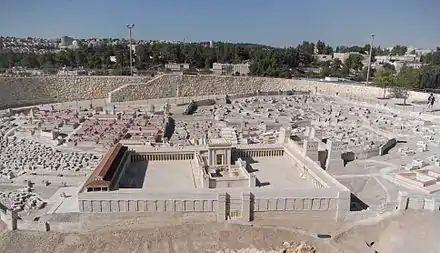
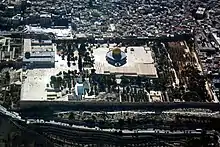
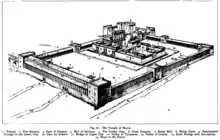
Temenos expansion, date and duration
Reconstruction of the temple under Herod began with a massive expansion of the Temple Mount temenos. For example, the Temple Mount complex initially measured 7 hectares (17 acres) in size, but Herod expanded it to 14.4 hectares (36 acres) and so doubled its area.[26] Herod's work on the Temple is generally dated from 20/19 BCE until 12/11 or 10 BCE. Writer Bieke Mahieu dates the work on the Temple enclosures from 25 BCE and that on the Temple building in 19 BCE, and situates the dedication of both in November 18 BCE.[27]
Religious worship and temple rituals continued during the construction process.[28] An agreement was made between Herod and the Jewish religious authorities: the sacrificial rituals, called korbanot (offerings), were to be continued unabated for the entire time of construction, and the Temple itself would be constructed by the priests. This is the reason Herod's Temple is still counted as the Second — functioning did not stop, although it was the third building fulfilling the purpose.
Extent and financing
The old temple built by Zerubbabel was replaced by a magnificent edifice. Herod's Temple was one of the larger construction projects of the 1st century BCE.[29] Josephus records that Herod was interested in perpetuating his name through building projects, that his construction programs were extensive and paid for by heavy taxes, but that his masterpiece was the Temple of Jerusalem.[29]
Later, the sanctuary shekel was reinstituted to support the temple as the temple tax.[30]
Platform, substructures, retaining walls
Mt. Moriah had a plateau at the northern end, and steeply declined on the southern slope. It was Herod's plan that the entire mountain be turned into a giant square platform. The Temple Mount was originally intended to be 1,600 feet (490 m) wide by 900 feet (270 m) broad by 9 stories high, with walls up to 16 feet (4.9 m) thick, but had never been finished. To complete it, a trench was dug around the mountain, and huge stone "bricks" were laid. Some of these weighed well over 100 tons, the largest measuring 44.6 by 11 by 16.5 feet (13.6 m × 3.4 m × 5.0 m) and weighing approximately 567-628 tons.[lower-alpha 3][31]
King Herod had architects from Greece, Rome and Egypt plan the construction. The blocks were presumably quarried by using pickaxes to create channels. Then they hammered in wooden beams and flushed them with water to force them out. Once they were removed, they were carved into precise squares and numbered at the quarry to show where they would be installed. The final carving would have been done by using harder stones to grind or chisel them to create precise joints. They would have been transported using oxen and specialized carts. Since the quarry was uphill from the temple they had gravity on their side but care needed to be taken to control the descent. Final installation would have been done using pulleys or cranes. Roman pulleys and cranes were not strong enough to lift the blocks alone so they may have used multiple cranes and levers to position them.[32]
The project began with the building of giant underground vaults upon which the temple would be built so it could be larger than the small flat area on top of Mount Moriah. Ground level at the time was at least 20 ft (6.1 m) below the current level, as can be seen by walking the Western Wall tunnels. Legend has it that the construction of the entire complex lasted only three years, but written sources such as Josephus say that it took far longer, although the Temple itself may only have taken that long. During a Passover visit by Jesus, he was told that it had been under construction for 46 years.[33]
Court of the Gentiles
The Court of the Gentiles was primarily a bazaar, with vendors selling souvenirs, sacrificial animals, food. Currency was also exchanged, with Roman currency exchanged for Tyrian money, as also mentioned in the New Testament account of Jesus and the Money Changers, when Jerusalem was packed with Jewish pilgrims who had come for Passover, perhaps numbering 300,000 to 400,000.[34][35]
Above the Huldah Gates, on top the Temple walls, was the Royal Stoa, a large basilica praised by Josephus as "more worthy of mention than any other [structure] under the sun"; its main part was a lengthy Hall of Columns which includes 162 columns, structured in four rows.[36]

The Royal Stoa is widely accepted to be part of Herod's work; however, recent archaeological finds in the Western Wall tunnels suggest that it was built in the first century during the reign of Agripas, as opposed to the 1st century BCE.[37]
Pinnacle
The accounts of the temptation of Christ in the gospels of Matthew and Luke both suggest that the Second Temple had one or more 'pinnacles':
Then he [Satan] brought Him to Jerusalem, set Him on the pinnacle of the temple, and said to Him, "If You are the Son of God, throw Yourself down from here."[38]
The Greek word used is πτερυγιον (pterugion), which literally means a tower, rampart, or pinnacle.[39] According to Strong's Concordance, it can mean little wing, or by extension anything like a wing such as a battlement or parapet.[40] The archaeologist Benjamin Mazar thought it referred to the southeast corner of the Temple overlooking the Kidron Valley.[41]
Inner courts
According to Josephus, there were ten entrances into the inner courts, four on the south, four on the north, one on the east and one leading east to west from the Court of Women to the court of the Israelites, named the Nicanor Gate.[42] According to Josephus, Herod the Great erected a golden eagle over the great gate of the Temple.[43]
Pilgrimages
Jews from distant parts of the Roman Empire would arrive by boat at the port of Jaffa, where they would join a caravan for the three-day trek to the Holy City and would then find lodgings in one of the many hotels or hostelries. Then they changed some of their money from the profane standard Greek and Roman currency for Jewish and Tyrian money, the latter two considered religious.[44][45]
Destruction
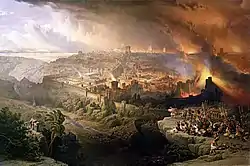
_03.jpg.webp)
In 66 CE the Jewish population rebelled against the Roman Empire. Four years later, on 4 August 70 CE[46] (the 9th day of Av and possibly the day on which Tisha B'Av was observed[47]) or 30 August 70 CE,[48] Roman legions under Titus retook and destroyed much of Jerusalem and the Second Temple. The Arch of Titus, which was built in Rome to commemorate Titus's victory in Judea, depicts a Roman victory procession with soldiers carrying spoils from the Temple, including the Menorah. According to an inscription on the Colosseum, Emperor Vespasian built the Colosseum with war spoils in 79 CE – possibly from the spoils of the Second Temple.[49]
The sects of Judaism that had their base in the Temple dwindled in importance, including the priesthood and the Sadducees.[50]
The Temple was on the site of what today is the Dome of the Rock. The gates led out close to Al-Aqsa Mosque (which came much later).[28] Although Jews continued to inhabit the destroyed city, Emperor Hadrian established a new city called Aelia Capitolina. At the end of the Bar Kokhba revolt in 135 CE, many of the Jewish communities were massacred and Jews were banned from living inside Jerusalem.[25] A pagan Roman temple was set up on the former site of Herod's Temple.
Historical accounts relate that not only the Jewish Temple was destroyed, but also the entire Lower city of Jerusalem.[51] Even so, according to Josephus, Titus did not totally raze the towers (such as the Tower of Phasael, now erroneously called the Tower of David), keeping them as a memorial of the city's strength.[52][53] The Midrash Rabba (Eikha Rabba 1:32) recounts a similar episode related to the destruction of the city, according to which Rabban Yohanan ben Zakkai, during the Roman siege of Jerusalem, requested of Vespasian that he spare the westernmost gates of the city (Hebrew: פילי מערבאה) that lead to Lydda (Lod). When the city was eventually taken, the Arab auxiliaries who had fought alongside the Romans under their general, Fanjar, also spared that westernmost wall from destruction.[54]
Jewish eschatology includes a belief that the Second Temple will be replaced by a future Third Temple in Jerusalem; Eastern Orthodox Christians contend that the Third Temple already exists in every consecrated and canonical church through the real presence of Christ in the Eucharist.[55]
Archaeology
Temple warning inscriptions
In 1871, a hewn stone measuring 60 cm × 90 cm (24 in × 35 in) and engraved with Greek uncials was discovered near a court on the Temple Mount in Jerusalem and identified by Charles Simon Clermont-Ganneau as being the Temple Warning inscription. The stone inscription outlined the prohibition extended unto those who were not of the Jewish nation to proceed beyond the soreg separating the larger Court of the Gentiles and the inner courts. The inscription read in seven lines:
ΜΗΟΕΝΑΑΛΛΟΓΕΝΗΕΙΣΠΟ
ΡΕΥΕΣΟΑΙΕΝΤΟΣΤΟΥΠΕ
ΡΙΤΟΙΕΡΟΝΤΡΥΦΑΚΤΟΥΚΑΙ
ΠΕΡΙΒΟΛΟΥΟΣΔΑΝΛΗ
ΦΘΗΕΑΥΤΩΙΑΙΤΙΟΣΕΣ
ΤΑΙΔΙΑΤΟΕΞΑΚΟΛΟΥ
ΘΕΙΝΘΑΝΑΤΟΝ
Translation: "Let no foreigner enter within the parapet and the partition which surrounds the Temple precincts. Anyone caught [violating] will be held accountable for his ensuing death."
Today, the stone is preserved in Istanbul's Museum of Antiquities.[56]
In 1935 a fragment of another similar Temple warning inscription was found.[56]
Place of trumpeting
Another ancient inscription, partially preserved on a stone discovered below the southwest corner of the Herodian Mount, contains the words "to the place of trumpeting...". The stone's shape suggests that it was part of a parapet, and it has been interpreted as belonging to a spot on the Mount described by Josephus, "where one of the priests to stand and to give notice, by sound of trumpet, in the afternoon of the approach, and on the following evening of the close, of every seventh day..."[57] closely resembling what the Talmud says.[58]
Walls and gates of the Temple complex
After 1967, archaeologists found that the wall extended all the way around the Temple Mount and is part of the city wall near the Lions' Gate. Thus, the Western Wall is not the only remaining part of the Temple Mount. Currently, Robinson's Arch (named after American Edward Robinson) remains as the beginning of an arch that spanned the gap between the top of the platform and the higher ground farther away. Visitors and pilgrims also entered through the still-extant, but now plugged, gates on the southern side that led through colonnades to the top of the platform. The Southern wall was designed as a grand entrance.[59] Recent archaeological digs have found numerous mikvehs (ritual baths) for the ritual purification of the worshipers, and a grand stairway leading to one of the now blocked entrances.[59]
Underground structures
Inside the walls, the platform was supported by a series of vaulted archways, now called Solomon's Stables, which still exist. Their current renovation by the Waqf is extremely controversial.[60]
Quarry
On September 25, 2007, Yuval Baruch, archaeologist with the Israeli Antiquities Authority announced the discovery of a quarry compound that may have provided King Herod with the stones to build his Temple on the Temple Mount. Coins, pottery and an iron stake found proved the date of the quarrying to be about 19 BCE. Archaeologist Ehud Netzer confirmed that the large outlines of the stone cuts is evidence that it was a massive public project worked by hundreds of slaves.[61]
Floor tiling from courts
More recent findings from the Temple Mount Sifting Project include floor tiling from the Second Temple period.[62]
Magdala stone interpretation
The Magdala stone is thought to be a representation of the Second Temple carved before its destruction in the year 70.[63]
Gallery
.jpg.webp) Magdala Stone
Magdala Stone Bar Kokhba tetradrachm showing the Jerusalem Temple façade 132–135 CE
Bar Kokhba tetradrachm showing the Jerusalem Temple façade 132–135 CE Arch of Titus showing spoils of Jerusalem Temple
Arch of Titus showing spoils of Jerusalem Temple Part of the south-western upper corner of Herod's temple colonnade with ancient "Trumpeting Place" Hebrew inscription.
Part of the south-western upper corner of Herod's temple colonnade with ancient "Trumpeting Place" Hebrew inscription. The Warning Inscription found in 1871
The Warning Inscription found in 1871 A copy of the temple warning inscription found in 1871
A copy of the temple warning inscription found in 1871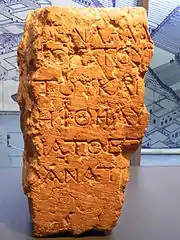 Fragment of Second Temple Warning
Fragment of Second Temple Warning The Trumpeting Place inscription, a stone (2.43 m × 1 m (8 ft 0 in × 3 ft 3 in)) with Hebrew inscription "To the Trumpeting Place" excavated by Benjamin Mazar at the southern foot of the Temple Mount is believed to be a part of the Second Temple.
The Trumpeting Place inscription, a stone (2.43 m × 1 m (8 ft 0 in × 3 ft 3 in)) with Hebrew inscription "To the Trumpeting Place" excavated by Benjamin Mazar at the southern foot of the Temple Mount is believed to be a part of the Second Temple.
Second Temple Judaism
The period between the construction of the Second Temple in 515 BCE and its destruction by the Romans in 70 CE witnessed major historical upheavals and significant religious changes that would affect most subsequent Abrahamic religions. The origins of the authority of scripture, of the centrality of law and morality in religion, of the synagogue and of apocalyptic expectations for the future all developed in the Judaism of this period.
See also
- Archaeological remnants of the Jerusalem Temple
- Herodian architecture
- Jerusalem stone
- List of artifacts significant to the Bible
- List of megalithic sites
- Replicas of the Jewish Temple
- Temple of Peace, Rome
- Temple in Jerusalem
- Timeline of Jewish history
Notes
- Based on regnal years of Darius I, brought down in Richard Parker & Waldo Dubberstein's Babylonian Chronology, 626 B.C.–A.D. 75, Brown University Press: Providence 1956, p. 30. However, Jewish tradition holds that the Second Temple stood for only 420 years, i.e. from 352 BCE – 68 CE. See: Hadad, David (2005). Sefer Maʻaśe avot (in Hebrew) (4 ed.). Beer Sheba: Kodesh Books. p. 364. OCLC 74311775. (with endorsements by Rabbi Ovadia Yosef, Rabbi Shlomo Amar, and Rabbi Yona Metzger); Sar-Shalom, Rahamim (1984). She'harim La'Luah Ha'ivry (Gates to the Hebrew Calendar) (in Hebrew). Tel-Aviv. p. 161 (Comparative chronological dates). OCLC 854906532.; Maimonides (1974). Sefer Mishneh Torah - HaYad Ha-Chazakah (Maimonides' Code of Jewish Law) (in Hebrew). Vol. 4. Jerusalem: Pe'er HaTorah. pp. 184–185 [92b–93a] (Hil. Shmitta ve-yovel 10:2–4). OCLC 122758200.
According to this calculation, this year which is one-thousand, one-hundred and seven years following the destruction, which year in the Seleucid era counting is [today] the 1,487th year (corresponding with Tishri 1175–Elul 1176 CE), being the year 4,936 anno mundi, it is a Seventh Year [of the seven-year cycle], and it is the 21st year of the Jubilee" (END QUOTE). = the destruction occurring in the lunar month of Av, two months preceding the New Year of 3,829 anno mundi.
- Classical Jewish records (e.g. Maimonides' Responsa, etc.) put the Second Temple period from 352 BCE to 68 CE, a total of 420 years.
- The History Channel cited the 16.5 depth 567 ton estimate in "Lost Worlds of King Herod"
References
- Schiffman, Lawrence H. (2003). Understanding Second Temple and Rabbinic Judaism. New York: KTAV Publishing House. pp. 48–49. ISBN 978-0881258134.
- Ezra 6:15,16
- Albright, William (1963). The Biblical Period from Abraham to Ezra: An Historical Survey. HarperCollins College Division. ISBN 0-06-130102-7.
-
 Singer, Isidore; et al., eds. (1901–1906). "Temple, The Second". The Jewish Encyclopedia. New York: Funk & Wagnalls.
Singer, Isidore; et al., eds. (1901–1906). "Temple, The Second". The Jewish Encyclopedia. New York: Funk & Wagnalls. - Zevit, Ziony (2008). "From Judaism to Biblical Religion and Back Again". The Hebrew Bible: New Insights and Scholarship. New York University Press. p. 166. ISBN 9780814731871.
- Cartledge, Paul; Garnsey, Peter; Gruen, Erich S., eds. (1997). Hellenistic Constructs: Essays In Culture, History, and Historiography. California: University of California Press. p. 92. ISBN 0-520-20676-2.
- Ezra 2:65
- Easton, Matthew George (1897). . Easton's Bible Dictionary (New and revised ed.). T. Nelson and Sons.
- Ezra 2
- Haggai 2:3, Zechariah 4:10
- 2 Chronicles 36:22–23
- Ezra 5:6–6:15
- Haggai 2:9
- Middot 3:6
- Ezra 1:7–11
- "Yoma 21b:7". www.sefaria.org.
- Seder Olam Rabbah chapter 30; Tosefta (Zevahim 13:6); Jerusalem Talmud (Megillah 18a); Babylonian Talmud (Megillah 11b-12a; Arakhin 12b; Baba Bathra 4a), Maimonides, Mishneh Torah (Hil. Shmita ve-yovel 10:3). Cf. Goldwurm, Hersh. History of the Jewish people: the Second Temple era, Mesorah Publications, 1982. Appendix: Year of the Destruction, p. 213. ISBN 0-89906-454-X
- Birnbaum, Philip (1975). "Kodashim". A Book of Jewish Concepts. New York, NY: Hebrew Publishing Company. pp. 541–542. ISBN 088482876X.
- Epstein, Isidore, ed. (1948). "Introduction to Seder Kodashim". The Babylonian Talmud. Vol. 5. Singer, M.H. (translator). London: The Soncino Press. pp. xvii–xxi.
- Arzi, Abraham (1978). "Kodashim". Encyclopedia Judaica. Vol. 10 (1st ed.). Jerusalem, Israel: Keter Publishing House Ltd. pp. 1126–1127.
- "The Battle of Panion (200 BC)". De Bellis Antiquitatis (DBA). Archived from the original on 2009-12-23.
- Josephus, Flavius (2012-06-29). "The Wars of the Jews". p. i. 34.
-
 One or more of the preceding sentences incorporates text from a publication now in the public domain: Kaufmann, Kohler (1901–1906). "Ḥanukkah". In Singer, Isidore; et al. (eds.). The Jewish Encyclopedia. New York: Funk & Wagnalls.
One or more of the preceding sentences incorporates text from a publication now in the public domain: Kaufmann, Kohler (1901–1906). "Ḥanukkah". In Singer, Isidore; et al. (eds.). The Jewish Encyclopedia. New York: Funk & Wagnalls. - Goldman, Ari L. (2000). Being Jewish: The Spiritual and Cultural Practice of Judaism Today. Simon & Schuster. p. 141. ISBN 978-0-684-82389-8.
- Lester L. Grabbe (2010). An Introduction to Second Temple Judaism: History and Religion of the Jews in the Time of Nehemiah, the Maccabees, Hillel, and Jesus. A&C Black. pp. 19–20, 26–29. ISBN 9780567552488.
- Petrech & Edelcopp, "Four stages in the evolution of the Temple Mount", Revue Biblique (2013), pp. 343-344
- Mahieu, B., Between Rome and Jerusalem, OLA 208, Leuven: Peeters, 2012, pp. 147–165
- Leen and Kathleen Ritmeyer (1998). Secrets of Jerusalem's Temple Mount.
- Flavius Josephus: The Jewish War
- Exodus 30:13
- Dan Bahat: Touching the Stones of our Heritage, Israeli ministry of Religious Affairs, 2002
- Modern Marvels: Bible tech, History channel
- John 2:20
- Sanders, E. P. The Historical Figure of Jesus. Penguin, 1993. p. 249
- Funk, Robert W. and the Jesus Seminar. The Acts of Jesus: The Search for the Authentic Deeds of Jesus. HarperSanFrancisco. 1998.
- Mazar, Benjamin (1979). "The Royal Stoa in the Southern Part of the Temple Mount". Proceedings of the American Academy for Jewish Research. 46/47: 381–387. doi:10.2307/3622363. ISSN 0065-6798. JSTOR 3622363.
- "Israel Antiquities Authority".
- Luke 4:9
- Kittel, Gerhard, ed. (1976) [1965]. Theological Dictionary of the New Testament: Volume III. Translated by Bromiley, Geoffrey W. Grand Rapids, Michigan: Wm. B. Eerdmans. p. 236.
- Strong's Concordance 4419
- Mazar, Benjamin (1975). The Mountain of the Lord, Doubleday. p. 149.
- Josephus, War 5.5.2; 198; m. Mid. 1.4
- Josephus, War 1.648-655; Ant 17.149-63. On this, see inter alia: Albert Baumgarten, 'Herod's Eagle', in Aren M. Maeir, Jodi Magness and Lawrence H. Schiffman (eds), 'Go Out and Study the Land' (Judges 18:2): Archaeological, Historical and Textual Studies in Honor of Hanan Eshel (JSJ Suppl. 148; Leiden: Brill, 2012), pp. 7–21; Jonathan Bourgel, "Herod's golden eagle on the Temple gate: a reconsideration," Journal of Jewish Studies 72 (2021), pp. 23-44.
- Sanders, E. P. The Historical Figure of Jesus. Penguin, 1993.
- Ehrman, Bart D. Jesus, Interrupted, HarperCollins, 2009. ISBN 0-06-117393-2
- "Hebrew Calendar". www.cgsf.org.
- Tisha B'Av is a day of mourning, which is considered inappropriate for the joyful atmosphere of the Sabbath. Thus, if its date falls on a Sabbath, it is observed on the 10th of Av instead. If this modern Jewish practice was followed in the Second Temple period, Tisha B'Av would have fallen on Sunday August 5 in 70 CE. Josephus gives the date of 10 Loos for the destruction, in a lunar calendar almost identical to the Hebrew calendar.
- Bunson, Matthew (1995). A Dictionary of the Roman Empire. Oxford University Press. p. 212. ISBN 978-0195102338.
- Bruce Johnston. "Colosseum 'built with loot from sack of Jerusalem temple'". Telegraph. Archived from the original on 2022-01-11.
- Alföldy, Géza (1995). "Eine Bauinschrift aus dem Colosseum". Zeitschrift für Papyrologie und Epigraphik. 109: 195–226. JSTOR 20189648.
- Josephus (The Jewish War 6.6.3.). Quote: "...So he (Titus) gave orders to the soldiers both to burn and plunder the city; who did nothing indeed that day; but on the next day they set fire to the repository of the archives, to Acra, to the council-house, and to the place called Ophlas; at which time the fire proceeded as far as the palace of queen Helena, which was in the middle of Acra: the lanes also were burnt down, as were also those houses that were full of the dead bodies of such as were destroyed by famine" (END QUOTE).
- Josephus (The Jewish War 7.1.1.), Quote: "Caesar gave orders that they should now demolish the entire city and temple, but should leave as many of the towers standing as were of the greatest eminence; that is, Phasael, and Hippicus, and Mariamme, and so much of the wall as enclosed the city on the west side. This wall was spared, in order to afford a camp for such as were to lie in garrison; as were the towers also spared, in order to demonstrate to posterity what kind of city it was, and how well fortified, which the Roman valour had subdued" (END QUOTE).
- Ben Shahar, Meir (2015). "When was the Second Temple Destroyed? Chronology and Ideology in Josephus and in Rabbinic Literature". Journal for the Study of Judaism in the Persian, Hellenistic, and Roman Period. Brill. 46 (4/5): 562. doi:10.1163/15700631-12340439. JSTOR 24667712.
- Midrash Rabba (Eikha Rabba 1:32)
- "A Christian view of the coming Temple - opinion". The Jerusalem Post.
- Zion, Ilan Ben. "Ancient Temple Mount 'warning' stone is 'closest thing we have to the Temple'". www.timesofisrael.com.
- Josephus (1961). The Jewish War, 4, 9 (PDF). Josephus, Vol. III. Translated by H. St. J. Thackeray (reprint (first edition: 1928) ed.). pp. 171+173, 172 (note a). Retrieved 17 July 2020.
- ""To the place of trumpeting …," Hebrew inscription on a parapet from the Temple Mount". Jerusalem: The Israel Museum. Retrieved 24 July 2020.
- Mazar, Eilat (2002). The Complete Guide to the Temple Mount Excavations. Jerusalem: Shoham Academic Research and Publication. pp. 55–57. ISBN 978-965-90299-1-4.
- "Debris removed from Temple Mount sparks controversy".
- Gaffney, Sean (2007-09-24). "USATODAY.com, Report: Herod's Temple quarry found". USA Today. Retrieved 2013-08-31.
- "Second Temple Flooring restored". Haaretz. Retrieved 13 October 2019.
- Kershner, Isabel (8 December 2015). "A Carved Stone Block Upends Assumptions About Ancient Judaism". The New York Times. Retrieved 9 December 2015.
Further reading
| Library resources about Second Temple |
- Grabbe, Lester. 2008. A History of the Jews and Judaism in the Second Temple Period. 2 vols. New York: T&T Clark.
- Nickelsburg, George. 2005. Jewish Literature between the Bible and the Mishnah: A Historical and Literary Introduction. 2nd ed. Minneapolis: Fortress.
- Schiffman, Lawrence, ed. 1998. Texts and Traditions: A Source Reader for the Study of Second Temple and Rabbinic Judaism. Hoboken, NJ: KTAV.
- Stone, Michael, ed. 1984. The Literature of the Jewish People in the Period of the Second Temple and the Talmud. 2 vols. Philadelphia: Fortress.
External links
- Second Temple and Talmudic Era The Jewish History Resource Center, Project of the Dinur Center for Research in Jewish History, The Hebrew University of Jerusalem
- Jewish Encyclopedia: Temple of Herod
- Jewish Encyclopedia: Temple, The Second
- 4 Enoch: The Online Encyclopedia of Second Temple Judaism
- Second Temple of Jerusalem (renders album of 3d model) / Zonerama photo gallery
- Jerusalem Videos The Southern & Western walls in Jerusalem – The Temple Mount
- Temple Mount Photos The Temple Mount photos including sites below the Mount itself, off limits to any non-Muslims
- PBS Frontline: Temple Culture
- Picture gallery of a model of the temple
